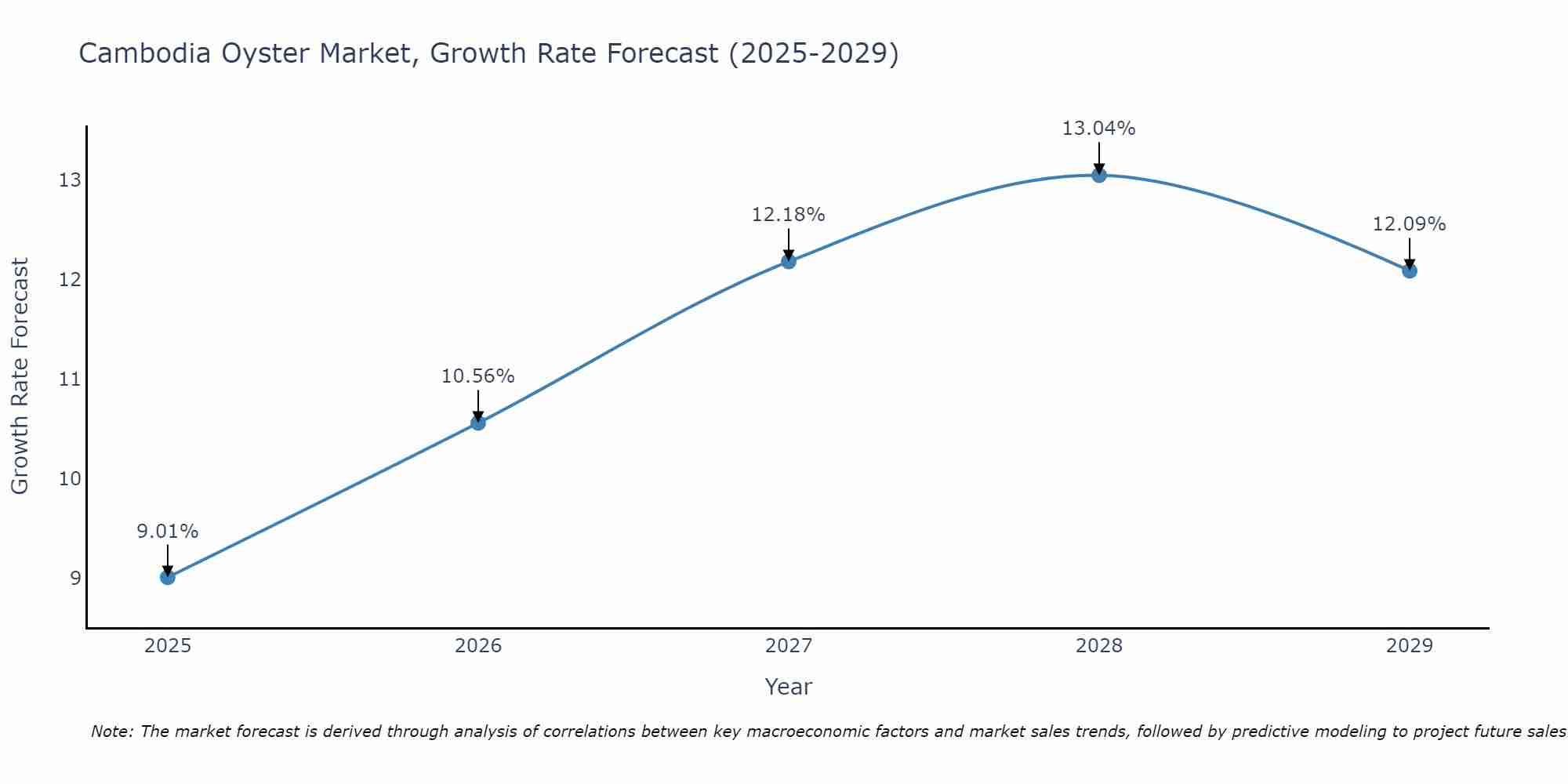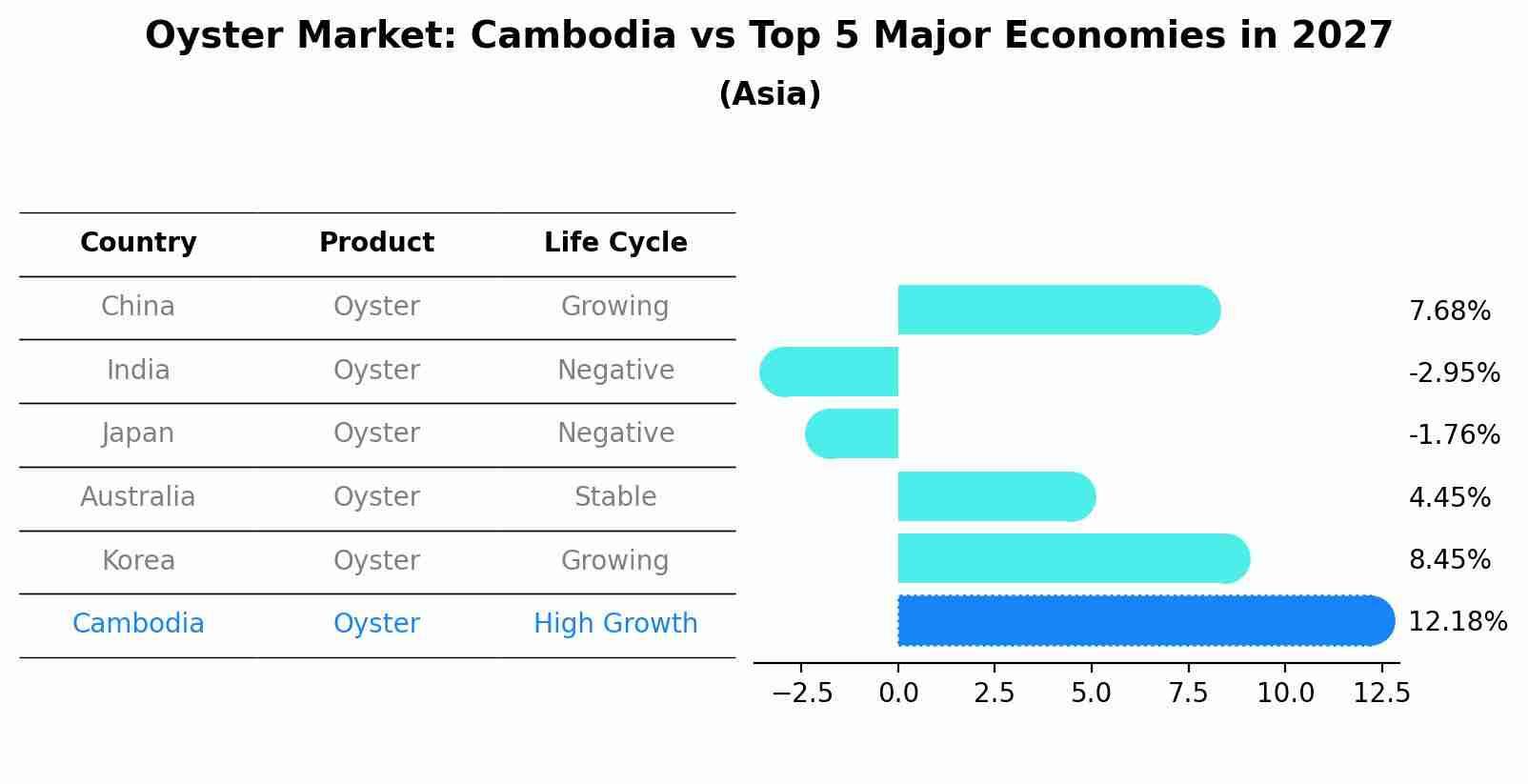Cambodia Oyster Market (2025-2031) Outlook | Trends, Value, Revenue, Forecast, Industry, Size, Growth, Share, Companies & Analysis
| Product Code: ETC387513 | Publication Date: Aug 2022 | Updated Date: Jul 2025 | Product Type: Market Research Report | |
| Publisher: 6Wresearch | Author: Sumit Sagar | No. of Pages: 75 | No. of Figures: 35 | No. of Tables: 20 |
Cambodia Oyster Market Size Growth Rate
The Cambodia Oyster Market is projected to witness mixed growth rate patterns during 2025 to 2029. The growth rate begins at 9.01% in 2025, climbs to a high of 13.04% in 2028, and moderates to 12.09% by 2029.

Oyster Market: Cambodia vs Top 5 Major Economies in 2027 (Asia)
Cambodia's Oyster market is anticipated to experience a high growth rate of 12.18% by 2027, reflecting trends observed in the largest economy China, followed by India, Japan, Australia and South Korea.

Cambodia Oyster Market Synopsis
The Cambodia oyster market is experiencing steady growth due to increasing consumer awareness of the health benefits of oysters. Oysters are a popular seafood choice in Cambodia, known for their rich flavor and nutritional value. The market is primarily driven by the growing demand from both domestic consumers and the tourism industry. Local oyster farms play a significant role in meeting this demand, with most oyster production concentrated in coastal areas such as Kampot and Kep. However, challenges such as environmental issues and the need for improved farming practices exist within the market. Overall, the Cambodia oyster market presents opportunities for expansion and innovation, particularly in sustainable farming methods and product diversification to cater to the evolving preferences of consumers.
Cambodia Oyster Market Trends
In Cambodia, the oyster market is experiencing a growing demand due to the increasing popularity of seafood consumption among locals and tourists. The market is seeing a trend towards sustainable and environmentally friendly oyster farming practices, with a focus on organic and locally sourced products. Consumers are also showing a preference for premium oysters that are fresh, flavorful, and of high quality. There is a rise in the number of restaurants and seafood vendors offering oyster dishes, catering to the growing interest in diverse culinary experiences. Additionally, there is a growing awareness of the health benefits of oysters, driving their consumption as a nutritious and protein-rich food choice. Overall, the Cambodia oyster market is witnessing a positive growth trajectory driven by changing consumer preferences and a focus on sustainability.
Cambodia Oyster Market Challenges
In the Cambodia oyster market, several challenges are faced, including issues with water quality and pollution affecting oyster growth and safety. Limited awareness and understanding of the nutritional benefits of oysters among consumers pose a challenge in expanding market demand. Additionally, the lack of standardized farming practices and quality control measures lead to inconsistencies in product quality, impacting consumer trust and market competitiveness. Infrastructure constraints, such as inadequate storage and transportation facilities, further hinder the distribution of oysters to wider markets. Furthermore, the industry faces difficulties in accessing capital for investment in modernizing production techniques and expanding cultivation areas. Overcoming these challenges will require collaboration among stakeholders to improve water management practices, enhance consumer education, implement quality assurance protocols, and invest in infrastructure development for sustainable growth of the Cambodia oyster market.
Cambodia Oyster Market Investment Opportunities
The Cambodia oyster market presents promising investment opportunities due to increasing demand both domestically and internationally. With the growing popularity of oysters as a delicacy and a nutritious food option, there is a significant potential for expansion and development in oyster farming operations in Cambodia. Investing in innovative farming techniques, sustainable aquaculture practices, and market expansion strategies can help capitalize on the market growth. Additionally, leveraging Cambodia`s strategic location for exporting oysters to neighboring countries and beyond can further enhance the investment prospects in this sector. Overall, the Cambodia oyster market offers a lucrative investment landscape for investors looking to tap into the seafood industry`s growth and meet the rising demand for high-quality oysters.
Jordan Agar Market Government Policies
The Cambodian government has implemented various policies to regulate and support the oyster market in the country. These policies include licensing requirements for oyster farmers to ensure quality and safety standards are met, as well as monitoring and enforcement measures to prevent overfishing and protect the natural oyster habitats. Additionally, the government has set guidelines for sustainable oyster farming practices to promote environmental conservation and long-term viability of the industry. Furthermore, there are initiatives in place to provide technical assistance and financial support to oyster farmers to enhance productivity and competitiveness in the market. Overall, the government`s policies aim to foster a sustainable and thriving oyster market in Cambodia while balancing economic growth with environmental conservation efforts.
Cambodia Oyster Market Future Outlook
The Cambodia oyster market is expected to show steady growth in the coming years, driven by increasing demand for seafood products in the region. Factors such as rising consumer awareness about the health benefits of oysters, growing popularity of seafood in Cambodian cuisine, and expanding tourism industry are likely to contribute to the market`s growth. Additionally, advancements in oyster farming techniques and increased investment in aquaculture infrastructure are expected to boost production levels and improve product quality. With a focus on sustainability and quality control measures, the Cambodia oyster market is poised for expansion, presenting opportunities for both domestic producers and international market players looking to capitalize on the growing demand for oysters in the country.
Key Highlights of the Report:
- Cambodia Oyster Market Outlook
- Market Size of Cambodia Oyster Market, 2024
- Forecast of Cambodia Oyster Market, 2031
- Historical Data and Forecast of Cambodia Oyster Revenues & Volume for the Period 2021 - 2031
- Cambodia Oyster Market Trend Evolution
- Cambodia Oyster Market Drivers and Challenges
- Cambodia Oyster Price Trends
- Cambodia Oyster Porter's Five Forces
- Cambodia Oyster Industry Life Cycle
- Historical Data and Forecast of Cambodia Oyster Market Revenues & Volume By Oyster Type for the Period 2021 - 2031
- Historical Data and Forecast of Cambodia Oyster Market Revenues & Volume By Cupped Oyster for the Period 2021 - 2031
- Historical Data and Forecast of Cambodia Oyster Market Revenues & Volume By Pacific Cupped Oyster for the Period 2021 - 2031
- Historical Data and Forecast of Cambodia Oyster Market Revenues & Volume By American Cupped Oyster for the Period 2021 - 2031
- Historical Data and Forecast of Cambodia Oyster Market Revenues & Volume By Penguin Wing Oyster for the Period 2021 - 2031
- Historical Data and Forecast of Cambodia Oyster Market Revenues & Volume By Others for the Period 2021 - 2031
- Historical Data and Forecast of Cambodia Oyster Market Revenues & Volume By End User for the Period 2021 - 2031
- Historical Data and Forecast of Cambodia Oyster Market Revenues & Volume By Foodservice for the Period 2021 - 2031
- Historical Data and Forecast of Cambodia Oyster Market Revenues & Volume By Retail for the Period 2021 - 2031
- Historical Data and Forecast of Cambodia Oyster Market Revenues & Volume By Packaging Form for the Period 2021 - 2031
- Historical Data and Forecast of Cambodia Oyster Market Revenues & Volume By Fresh for the Period 2021 - 2031
- Historical Data and Forecast of Cambodia Oyster Market Revenues & Volume By Frozen for the Period 2021 - 2031
- Historical Data and Forecast of Cambodia Oyster Market Revenues & Volume By Canned for the Period 2021 - 2031
- Historical Data and Forecast of Cambodia Oyster Market Revenues & Volume By Others for the Period 2021 - 2031
- Cambodia Oyster Import Export Trade Statistics
- Market Opportunity Assessment By Oyster Type
- Market Opportunity Assessment By End User
- Market Opportunity Assessment By Packaging Form
- Cambodia Oyster Top Companies Market Share
- Cambodia Oyster Competitive Benchmarking By Technical and Operational Parameters
- Cambodia Oyster Company Profiles
- Cambodia Oyster Key Strategic Recommendations
Frequently Asked Questions About the Market Study (FAQs):
- Single User License$ 1,995
- Department License$ 2,400
- Site License$ 3,120
- Global License$ 3,795
Search
Related Reports
- Vietnam System Integrator Market (2025-2031) | Size, Companies, Analysis, Industry, Value, Forecast, Growth, Trends, Revenue & Share
- ASEAN and Thailand Brain Health Supplements Market (2025-2031) | Strategy, Consumer Insights, Analysis, Investment Trends, Opportunities, Growth, Size, Share, Industry, Revenue, Segments, Value, Segmentation, Supply, Forecast, Restraints, Outlook, Competition, Drivers, Trends, Demand, Pricing Analysis, Competitive, Strategic Insights, Companies, Challenges
- ASEAN Bearings Market (2025-2031) | Strategy, Consumer Insights, Analysis, Investment Trends, Opportunities, Growth, Size, Share, Industry, Revenue, Segments, Value, Segmentation, Supply, Forecast, Restraints, Outlook, Competition, Drivers, Trends, Demand, Pricing Analysis, Competitive, Strategic Insights, Companies, Challenges
- Europe Flooring Market (2025-2031) | Outlook, Share, Industry, Trends, Forecast, Companies, Revenue, Size, Analysis, Growth & Value
- Saudi Arabia Manlift Market (2025-2031) | Outlook, Size, Growth, Trends, Companies, Industry, Revenue, Value, Share, Forecast & Analysis
- Uganda Excavator, Crane, and Wheel Loaders Market (2025-2031) | Strategy, Consumer Insights, Analysis, Investment Trends, Opportunities, Growth, Size, Share, Industry, Revenue, Segments, Value, Segmentation, Supply, Forecast, Restraints, Outlook, Competition, Drivers, Trends, Demand, Pricing Analysis, Competitive, Strategic Insights, Companies, Challenges
- Rwanda Excavator, Crane, and Wheel Loaders Market (2025-2031) | Strategy, Consumer Insights, Analysis, Investment Trends, Opportunities, Growth, Size, Share, Industry, Revenue, Segments, Value, Segmentation, Supply, Forecast, Restraints, Outlook, Competition, Drivers, Trends, Demand, Pricing Analysis, Competitive, Strategic Insights, Companies, Challenges
- Kenya Excavator, Crane, and Wheel Loaders Market (2025-2031) | Strategy, Consumer Insights, Analysis, Investment Trends, Opportunities, Growth, Size, Share, Industry, Revenue, Segments, Value, Segmentation, Supply, Forecast, Restraints, Outlook, Competition, Drivers, Trends, Demand, Pricing Analysis, Competitive, Strategic Insights, Companies, Challenges
- Angola Excavator, Crane, and Wheel Loaders Market (2025-2031) | Strategy, Consumer Insights, Analysis, Investment Trends, Opportunities, Growth, Size, Share, Industry, Revenue, Segments, Value, Segmentation, Supply, Forecast, Restraints, Outlook, Competition, Drivers, Trends, Demand, Pricing Analysis, Competitive, Strategic Insights, Companies, Challenges
- Israel Intelligent Transport System Market (2025-2031) | Strategy, Consumer Insights, Analysis, Investment Trends, Opportunities, Growth, Size, Share, Industry, Revenue, Segments, Value, Segmentation, Supply, Forecast, Restraints, Outlook, Competition, Drivers, Trends, Demand, Pricing Analysis, Competitive, Strategic Insights, Companies, Challenges
Industry Events and Analyst Meet
Our Clients
Whitepaper
- Middle East & Africa Commercial Security Market Click here to view more.
- Middle East & Africa Fire Safety Systems & Equipment Market Click here to view more.
- GCC Drone Market Click here to view more.
- Middle East Lighting Fixture Market Click here to view more.
- GCC Physical & Perimeter Security Market Click here to view more.
6WResearch In News
- Doha a strategic location for EV manufacturing hub: IPA Qatar
- Demand for luxury TVs surging in the GCC, says Samsung
- Empowering Growth: The Thriving Journey of Bangladesh’s Cable Industry
- Demand for luxury TVs surging in the GCC, says Samsung
- Video call with a traditional healer? Once unthinkable, it’s now common in South Africa
- Intelligent Buildings To Smooth GCC’s Path To Net Zero













